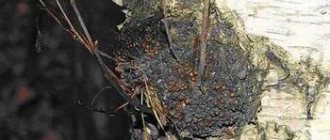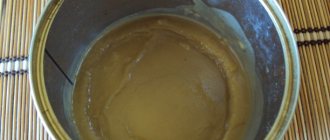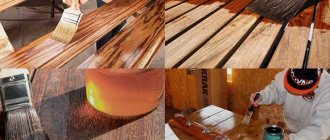Anyone who has had to work with wood, be it installing a wooden floor, carpentry work or wood crafts, is well aware of its most unpleasant property. No matter how high-quality the raw wood is, when it dries, it will certainly warp or develop deep cracks
Table of wood shrinkage of some tree species.
This happens because a living tree is filled with juices, like a sponge. Under the influence of air temperature, the top layer of wood dries out much faster than the inner layer. And the higher the air temperature, the greater this difference will be. But how can you dry wood so that it doesn’t crack and you can continue to work with it without fear of warping?
Requirements for drying wood
Methods of drying wood: a – natural, b – in a low-temperature chamber, c – under high-frequency currents, d – in a condensation chamber.
Drying consists of 2 processes that occur simultaneously in the tree. Moisture evaporates from the surface of the tree, and that which was originally inside the trunk moves from the center to its surface. The larger the workpiece, the longer it takes for the moisture to evaporate. For wood that will be used outdoors, the residual moisture content should be in the range of 12-18%. But if wood or wood products are supposed to be used in a heated room, then it will have to be additionally dried at room temperature. The residual humidity in it should not exceed 8-10%.
In production conditions, when drying wood, a special device is used to determine its moisture content - an electric moisture meter. But at home there is no need to purchase such a device for a couple of blanks. The moisture content of wood can be determined quite accurately by touch. To do this, just squeeze a few wooden shavings in your hand. If the wood is dry, the chips will break in your hand, and if not, they will be compressed.
If you have to start harvesting wood, remember: the tree has the least amount of moisture from the time it has completely shed its leaves until the buds begin to swell on it. If you decide to prepare wood for subsequent processing yourself, then it is better to do it during this period.
Let's take a closer look at the different methods of drying wood.
Why do wooden products crack and how to deal with it?
The use of artificial materials in the production of any product will never be a worthy and complete replacement for such natural raw materials as wood. And the point here is not only the elusive charm caused by its special smell and natural texture, but also the fact that with proper care, an object made of wood can last for many years, completely eliminating the feeling of that fakeness that plastic has.
Today literally everything is made from wood, from country houses, furniture and musical instruments to tiny crafts. For example, wooden stools brought from Asia are in particular demand. They can be beautifully detailed and skillfully finished, but often with their purchase a person becomes acquainted with a very common wood defect - the rapid formation of cracks.
Why does wood crack? Stools made from solid and laminated solid wood are repeatedly subjected to this, since in the first case the correctness of the technological process during drying and storage is often violated, and in the second, the use of low-quality glue leads to cracking. In addition, cracks may appear due to the natural aging of wood, or simply due to the climate in Russia compared to Indonesia or Thailand. When purchasing, it is important to pay attention to the fact that the stool has a uniform color without any stains. Color is the first indicator of the quality, age and condition of wood, which is almost impossible to disguise.
What causes wood cracking?
Due to the presence of the above-described disadvantage, the main performance indicators of wood are significantly reduced. Resistance to stress decreases and mold growth and rotting are quite obviously observed. In this case, the unprotected layers of wood face the negative environmental factors.
How to deal with wood cracking?
To minimize cracks as much as possible, you should try to keep the stool as far as possible from heat sources (heating appliances, fireplace) and closely monitor air humidity, because the higher the humidity, the higher the risk of further cracking of the product. Next, it is worth adequately assessing the size of the cracks, trying in advance to identify them at the initial stage. If the cracks are not wide and shallow, then you can either sand them with sandpaper and saturate the product with linseed oil, which is an environmentally friendly water-repellent, or use a special wood putty. It is reasonable to fill larger cracks with an arbogypsum composition (a mixture of sawdust and gypsum at a ratio of 5:1) or with a composition of sawdust and wood glue in a ratio of 5:1. Before you start processing, you should tilt the stool horizontally so that the solutions do not spread. Craftsmen familiar with carpentry can make an insert from the same type of wood.
Remember that wood is actually an excellent material for construction and manufacturing of various products. A trunk that has grown without deviations from the norm, proper storage of wood and its subsequent processing will naturally delay cracking, but natural material cannot be ideal forever and, having served its purpose, it will quite obviously “fade.”
P/S If you don’t have the opportunity or desire to do the restoration yourself, you can contact us, see details
Drying standing trees
Stand drying is considered the most reliable. It can be carried out from spring until the end of summer. Later, it will be problematic to properly dry the tree while standing, since at this time it moves less moisture along the trunk, preparing for hibernation.
A ring of bark is removed from a tree trunk at a distance of 0.3-0.5 m from the ground. The width of the ring can be taken arbitrarily, but most often it is made from 1 to 1.5 m. If you remove less bark, the drying time will increase, and removing more is inconvenient for many due to their growth.
Scheme for drying wood under atmospheric conditions.
This method is good because it allows you to dry the wood quickly. The removed bark does not allow moisture to enter the crown of the tree, while at the same time the foliage continues to intensively consume the moisture remaining in the trunk, dehydrating it. When the foliage on the tree dries, it can be cut down and divided. The wood in it will be dry, and it can be safely used for its intended purpose.
This method is good when you need to dry single trees quickly. But in the forest you can perform this process differently. The tree needs to be cut down, leaving a 0.7-1 m ring of bark around the trunk from the cut site. And then 2/3 of the trunk can be trimmed without touching the crown. The remaining foliage will continue to do its job for some time, drying out the tree trunk in a week in a way that under normal conditions it would not have dried out in a month.
After 2-3 weeks of such drying, the trunk is sawn into the pieces you need.
But you shouldn’t use them right away; the wood definitely needs to be dried.
This is done under a canopy, placing a 0.25-0.5 m high flooring under the wood to prevent even the slightest contact with the ground.
Drying methods
Based on the purposes for which the timber is intended to be used, the percentage of moisture in the output product is determined, on the basis of which the method of drying the wood is selected. There are several of them, each with its own characteristics and nuances.
The most common methods used to dry wood are:
- atmospheric;
- natural;
- chamber;
- contact;
- rotary.
There are other ways to dry wood, but they are less common or are used only in very large production environments.
Drying wood in atmospheric conditions
The workpiece is boiled in water for several hours. After boiling, it is dried away from sunlight.
For this purpose, a flat, dry area is selected on the site. The place should be on a hill to avoid flooding. A flooring of poles is constructed on it, on which the workpieces are stacked.
The top row of the stack, whether round timber or planks, is laid on a slight slope and covered to protect it from both rain and sun. If you use round timber from a coniferous tree for drying, then it is better not to remove the bark from it, otherwise, even covered, it will crack. To protect the ends of round timber from rotting, they are treated with lime, liquid glue or a solution of table salt.
This method allows you to remove about 75% of the moisture initially found in the wood. However, it cannot be used to dry the tree quickly - the average drying speed can be taken as 1 cm per year. But this value depends on numerous factors: the type of wood, the thickness and type of wood and weather conditions. Therefore, to guarantee it, it is better to assume that coniferous and soft hardwood wood takes 1-1.5 years to dry, and hardwood wood takes 2 years or more.
Atmospheric
Atmospheric drying is the simplest technologically. All that is needed to complete it is a platform for placing the material and a canopy for it, or at least some kind of covering. Drying boards or timber in this way is very simple - the material is stacked on a raised surface. The main condition for a normal drying process is to ensure the passage of air between the layers of wood. A canopy or cover is necessary to reduce precipitation on the stack, as well as to prevent exposure to direct sunlight. Before laying for drying, the boards must be treated with antiseptic substances to prevent the appearance of fungus. To dry a cut of wood without cracks, the ends are covered with resin, paint or soaked in oil.
The disadvantage of atmospheric drying is that the process of moisture release from wood depends on the environment. High air humidity can significantly delay drying time. And in general, with this method the wood takes a very long time to dry.
Drying wood using newspapers and straw
These methods are used when small pieces of wood need to be dried. When using newspapers, the wooden blank is wrapped in dry newspapers and then placed in a plastic bag. The bag is wrapped tightly and placed in a warm place - the warmer the better. When the newspaper in the bag becomes wet, open the bag, remove the wet newspaper from the workpiece and replace it with dry one.
Depending on the initial moisture content of the wood, this process may take 3-4 weeks. Over time, the intervals between newspaper changes will increase as there is less moisture in the workpiece. In this case, to speed up the drying process, you can increase the thickness of the newspaper layer, but remember that too rapid loss of moisture will lead to cracks.
Drying wood with dry straw uses the same principle as drying with newspaper. Only in this case, the wooden blanks are dried not in a warm place, but under a canopy, covered with a thick layer of dry straw. Straw, like newspapers, takes moisture from the tree, but, unlike newspapers, there is no need to change it every day, it dries itself. If straw is not at hand, dry shavings or sawdust can be replaced with no less success.
What kind of wood is light?
Forest wood is usually light-colored. Moreover, in some species the entire mass of wood is painted in one color (alder, birch, hornbeam), while in others the central part has a darker color (oak, larch, pine). The dark part of the trunk is called the core, and the light, peripheral part is called sapwood.
Interesting materials:
When can you eat milk mushrooms after pickling? When should I take Imodium before or after meals? When are peonies available in stores? Who eats the hawk? Who does omul eat? Who absolutely should not eat persimmons? Who absolutely should not eat tomatoes? Who shouldn't eat legumes? Who shouldn't eat beans? Who shouldn't eat beans?
Drying wood by steaming and boiling
These methods were used by our ancestors to dry blanks for wooden utensils. The essence of steaming is to replace the organic moisture inside the wood with vegetable oil. The workpiece is placed in any vegetable oil (in the old days they used linseed oil) and simmered over low heat for 5-6 hours. Although the time depends on the size of the workpiece - for small or thin workpieces an hour is enough. After steaming, the workpieces are dried in the sun.
When boiling, the workpiece is placed in water and boiled in it for several hours. The boiling time depends on the container of water and the size of the workpiece. After boiling, the workpiece is dried in an unheated room away from sunlight.
Many methods for drying wood have been developed, although not all of them can be used at home.
What is linden blossom good for?
Linden flowers have diaphoretic, choleretic, anti-inflammatory and antipyretic effects. And this medicinal plant is prescribed to men and women, including during pregnancy. Linden blossom is used in cosmetology to slow down the aging process, as well as strengthen nails and hair.
Interesting materials:
What is the means of user authentication? What is the raw material for the production of sulfuric acid? What goes with Burgundy? What comes after a magnificent century? What's included with iPhone 11? What did Elon Musk launch into space? What was used to irrigate fields in Ancient Egypt? What is used instead of roofing felt? What is a correspondence course? What did Aivazovsky depict in his paintings?
How to dry apple wood
Apple wood is the most common material among all types of fruit tree wood. This is due to the wide distribution of the plant itself.
Before drying apple tree wood , you need to create the right conditions and select a temperature regime that will ensure the preservation of the structure. After processing, the core should acquire a red-brown tint and yellow-pink sapwood, the rays of the core should be inconspicuous.
Apple tree wood is highly drying, heavy, hard, has average resistance to biological damage, and is also of average density. The shrinkage rate is even higher than that of hardwood.
All this suggests that apple tree wood needs to be dried in a special mode to avoid warping and cracking.
Drying recommended by professionals proceeds according to the following scheme:
- lumber is stacked in a place protected from weather influences;
- atmospheric drying is carried out until a certain humidity level is reached (20-25%);
- moisture-heat treatment and soft drying are carried out;
- Final drying is carried out at temperatures up to 60 degrees to a humidity of 12%.
When the process is carried out correctly, it takes 25-30 days, which takes a lot of time. But forcing the drying of apple wood leads to a decrease in quality.
How to dry wood
This tree species can figuratively be called universal, since logs and finished lumber from birch are dried in the same way as any other wood, which we will discuss in detail in this article. Before you start drying birch, it is important to block the pores at the ends of the workpieces and on their cross sections. Wood processors cover the ends and cuts using paint or glue, in particular PVA. If these actions are neglected, the ends and cross sections of birch blanks will dry out quite quickly than the main parts of the blanks. When a birch dries, it shrinks unevenly, decreases in size in some places more and more quickly, and in other places practically does not change its basic dimensions. As a result of this unfavorable uneven drying of the wood, a certain tension is formed in it, which, so to speak, is released and breaks the fibers of the material, forming cracks.










